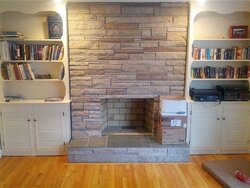- Dec 9, 2012
- 2
I have started to do some research on a wood-burning insert I can use in my 48-year-old living room fireplace that has never seen a fire. The existing opening is pretty decent size, as it will swallow up a Quadra-Fire 5100 if I want it to. Not sure I need anything quite that big. I've attached a pic. Note the cleanout, which is accessed behind the fireplace on the exterior of the house. Here are my criteria, and ideally, I'd like to find an insert that meets all criteria:
1) I want to provide outside air for combustion.
2) I strongly prefer a flush-mount installation. I have 18" from the vertical stone face to the front edge of the hearth, and I'd rather not have to extend my non-combustable surface.
3) I prefer contemporary styling.
3) I prefer porcelain enamel finish on the insert and on the surround.
4) I'm looking at inserts with firebox size around 2.4 cubic feet.
5) Need to heat about 1500 sf of floor area.
6) Would like to be able to load up the stove at 10:30 pm and quickly get a fire going again at 7:30 am.
Regarding OAK, can I use the existing cleanout? I've looked at several stoves online and have only found one that references an OAK in the literature: the Quadra-Fire Voyager Grand. Other insets I've looked at or researched thus far are:
- Enviro Cabella 1700 (no OAK, but I like it otherwise),
- Avalon (no OAK, but I like the size and styling; is it cast iron or steel?),
- Hearthstone Clydsdale (no OAK but I like it otherwise),
- Quadra-Fire 5100i (no OAK, probably too big for my application),
- Quadra-Fire Voyager Grand (only one I've found that mentions an OAK).
Thanks in advance for any feedback.
Regards,
Mark
1) I want to provide outside air for combustion.
2) I strongly prefer a flush-mount installation. I have 18" from the vertical stone face to the front edge of the hearth, and I'd rather not have to extend my non-combustable surface.
3) I prefer contemporary styling.
3) I prefer porcelain enamel finish on the insert and on the surround.
4) I'm looking at inserts with firebox size around 2.4 cubic feet.
5) Need to heat about 1500 sf of floor area.
6) Would like to be able to load up the stove at 10:30 pm and quickly get a fire going again at 7:30 am.
Regarding OAK, can I use the existing cleanout? I've looked at several stoves online and have only found one that references an OAK in the literature: the Quadra-Fire Voyager Grand. Other insets I've looked at or researched thus far are:
- Enviro Cabella 1700 (no OAK, but I like it otherwise),
- Avalon (no OAK, but I like the size and styling; is it cast iron or steel?),
- Hearthstone Clydsdale (no OAK but I like it otherwise),
- Quadra-Fire 5100i (no OAK, probably too big for my application),
- Quadra-Fire Voyager Grand (only one I've found that mentions an OAK).
Thanks in advance for any feedback.
Regards,
Mark


